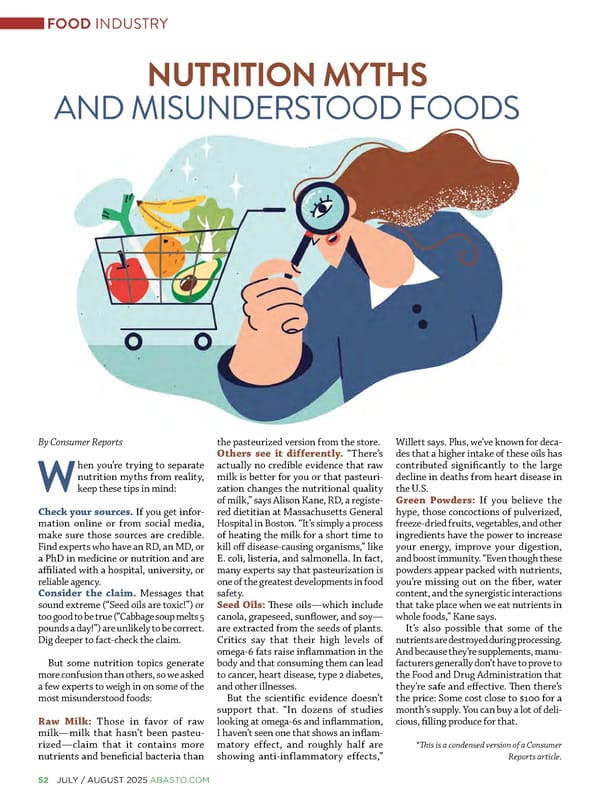By Consumer Reports W hen you’re trying to separate nutrition myths from reality, keep these tips in mind: Check your sources. If you get infor- mation online or from social media, make sure those sources are credible. Find experts who have an RD, an MD, or a PhD in medicine or nutrition and are affiliated with a hospital, university, or reliable agency. Consider the claim. Messages that sound extreme (“Seed oils are toxic!”) or too good to be true (“Cabbage soup melts 5 pounds a day!”) are unlikely to be correct. Dig deeper to fact-check the claim. But some nutrition topics generate more confusion than others, so we asked a few experts to weigh in on some of the most misunderstood foods: Raw Milk: Those in favor of raw milk—milk that hasn’t been pasteu- rized—claim that it contains more nutrients and beneficial bacteria than NUTRITION MYTHS AND MISUNDERSTOOD FOODS the pasteurized version from the store. Others see it differently. “There’s actually no credible evidence that raw milk is better for you or that pasteuri- zation changes the nutritional quality of milk,” says Alison Kane, RD, a registe- red dietitian at Massachusetts General Hospital in Boston. “It’s simply a process of heating the milk for a short time to kill off disease-causing organisms,” like E. coli, listeria, and salmonella. In fact, many experts say that pasteurization is one of the greatest developments in food safety. Seed Oils: These oils—which include canola, grapeseed, sunflower, and soy— are extracted from the seeds of plants. Critics say that their high levels of omega-6 fats raise inflammation in the body and that consuming them can lead to cancer, heart disease, type 2 diabetes, and other illnesses. But the scientific evidence doesn’t support that. “In dozens of studies looking at omega-6s and inflammation, I haven’t seen one that shows an inflam- matory effect, and roughly half are showing anti-inflammatory effects,” Willett says. Plus, we’ve known for deca- des that a higher intake of these oils has contributed significantly to the large decline in deaths from heart disease in the U.S. Green Powders: If you believe the hype, those concoctions of pulverized, freeze-dried fruits, vegetables, and other ingredients have the power to increase your energy, improve your digestion, and boost immunity. “Even though these powders appear packed with nutrients, you’re missing out on the fiber, water content, and the synergistic interactions that take place when we eat nutrients in whole foods,” Kane says. It’s also possible that some of the nutrients are destroyed during processing. And because they’re supplements, manu- facturers generally don’t have to prove to the Food and Drug Administration that they’re safe and effective. Then there’s the price: Some cost close to $100 for a month’s supply. You can buy a lot of deli- cious, filling produce for that. *This is a condensed version of a Consumer Reports article. FOOD INDUSTRY 52 JULY / AUGUST 2025 ABASTO.COM
 Abasto Magazine: July / August 2025 - ENGLISH Page 51 Page 53
Abasto Magazine: July / August 2025 - ENGLISH Page 51 Page 53